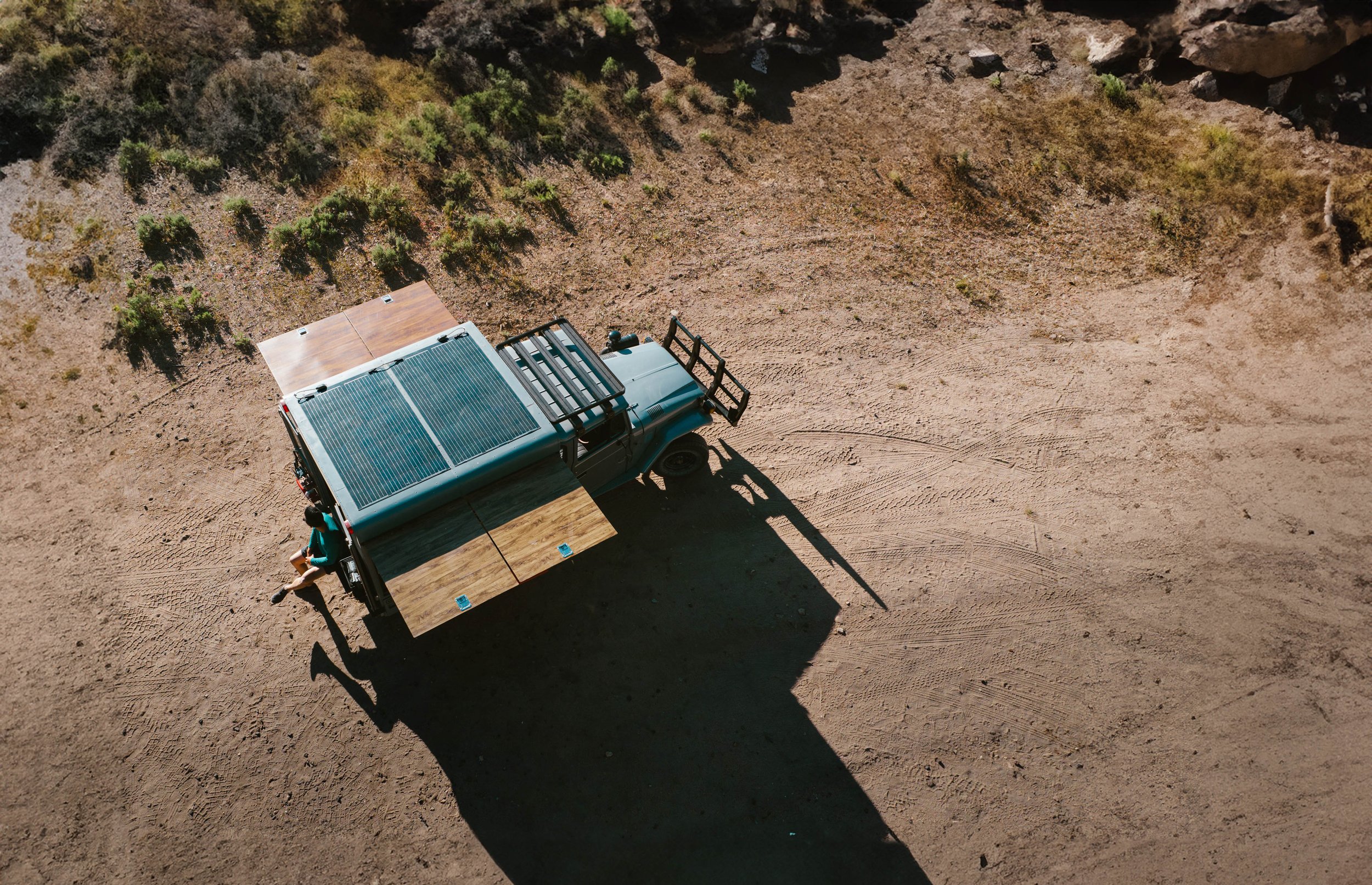Maximizing Solar Panel Efficiency for Overlanding Rigs, Camper Vans, and RVs
With the growing popularity of overlanding adventures and van life, many outdoor enthusiasts are opting for a solar energy system to power their journeys sustainably. Solar panels offer an eco-friendly and reliable solution for powering essential appliances, electronics, and devices during your travels.
When it comes to overlanding rigs, camper vans, and RVs, maximizing solar panel efficiency is essential for a sustainable and independent power source on the road. With increasing adventurers embracing the nomadic lifestyle, sustainable, renewable energy has become top priority. But how can you ensure your solar panels operate at their peak performance?
Whether you're a seasoned overlander looking to upgrade your setup or a newbie just starting out, we've gathered some best practices to help you optimize your solar panel system.
Calculate Your Electrical Power Needs
The first step to getting the most efficient solar panels for your needs is to determine your overall energy needs.
Catalog Items That Use Power: List all the electrical appliances and devices you plan to use on your trips. Include items such as lights, fans, refrigerator, laptop, phone chargers, water pump, and any other devices you'll use daily.
Understand Power Ratings: Next to each appliance or device on your list, note its power rating in watts. This information can usually be found on a label or the device's user manual. If the rating is given in amps, you can convert it to watts using Watts = Volts × Amps.
Calculate Total Power Consumption: For each device, calculate its daily energy consumption in watt-hours (Wh) by multiplying its power rating (in watts) by the hours you expect to use it in a day. For example, if you have a 50-watt light that you plan to use for 4 hours a day, the daily energy consumption would be 50 watts × 4 hours = 200 watt-hours. Add up the daily energy consumption of all your appliances and devices. This will give you the total daily energy requirement in watt-hours.
Conversion Efficiency: To be conservative, add about 20% to your daily energy requirement to account for inefficiencies and standby power. Remember that not all devices operate at their maximum power rating all the time; some have standby power consumption, and others might not be used at full power continuously.
Weather Considerations: Solar panels don't generate their maximum rated power on cloudy days. To account for this, you should estimate the hours of sunlight you'll typically receive daily in the area you'll be traveling. Multiply your total daily energy requirement by the average hours of sunlight to get an estimated solar energy generation requirement.
If you're unsure about any of the calculations, consulting with a professional specializing in photovoltaic systems for overlanding rigs, campervans, and RVs is a good idea. They can provide personalized guidance based on your specific needs and circumstances.
Battery Storage Capacity
It's important to pair your solar panels with the right battery bank to store excess energy for later use. The battery bank stores the excess energy generated by your solar panels during the day for use during the night or cloudy periods.
Here's how to determine the battery capacity you need and avoid mismatching your solar power output and battery intake capacities.
Account for Efficiency Losses: Batteries are not 100% efficient in storing and releasing energy. Typically, lead-acid batteries might have around 80-90% efficiency levels, while lithium-ion batteries have a better efficiency rating at around 95%. Account for these losses by dividing your calculated daily energy consumption by the battery's efficiency. This gives you the energy you need to generate from your solar panels to meet your daily consumption.
Match Solar Power Output and Battery Capacity: Your solar panel power output capacity should match your battery intake capacity. If you have too much solar power generation and insufficient battery capacity, you might end up with too much power generated that goes to waste. On the other hand, if you have too much battery capacity and insufficient solar power generation, your batteries might not fully charge, leading to inefficient energy use and not having enough electricity to power your items.
Plan for Days with Limited Sunlight: Consider days when you might have limited sunlight due to cloudy weather or other factors. Your battery capacity should sustain your energy consumption during these periods.
Choose Battery Type: Different battery types have varying capacities, discharge rates, and lifespans. Lead-acid batteries are typically less expensive but have shorter lifespans and might require more maintenance. Lithium-ion batteries, while more expensive, offer higher capacity, longer lifespans, and better efficiency with more usable energy.
Factor in Depth of Discharge: Batteries should not be discharged completely to prolong their lifespan. It's recommended to avoid discharging below 50% of their capacity for lead-acid batteries, while lithium-ion batteries can handle deeper discharges. Consider the battery's usable capacity when calculating how much capacity you need.
Consult with Experts: If you're uncertain about battery capacity calculations, it's advisable to consult with professionals who specialize in solar power setups. They can guide you based on your specific needs and help you avoid oversizing or under-sizing your battery bank.
Understanding Solar Panel Efficiency Ratings
Now that you've calculated how much power you will need daily, it's important to understand how solar panels work and the factors that affect total panel efficiency.
The efficiency of solar panels refers to the ratio of the panel's actual power output to the amount of sunlight it receives. It's typically represented as a percentage. A higher solar cell efficiency percentage indicates that the panel can convert more sunlight into usable electricity.
To determine the efficiency of a solar panel, you can use the following formula:
Efficiency (%) = (Power Output / Solar Irradiance) × 100
Where:
Power Output is the actual electricity generated by the panel in watts.
Solar Irradiance is the amount of sunlight energy falling on a unit area (usually measured in watts per square meter, W/m²).
The efficiency percentage of a solar panel indicates how effectively it can convert sunlight into electricity. For example, a panel with an efficiency of 20% can convert 20% of the sunlight it receives into usable electricity. The higher the efficiency percentage, the more power you can generate from fewer panels and a given amount of sunlight.
Maximum efficiency becomes particularly important when you have limited roof space on your overlanding rig, campervan, or RV. High-efficiency panels allow you to generate more power within a compact area, which can be advantageous for vehicles with limited surface space for solar panel installation.
Factors Affecting Solar Panel Efficiency
Several factors can impact the efficiency of your solar panels.
1. Cell Technology: Different solar panel manufacturers use various cell technologies, such as monocrystalline, polycrystalline, thin film, and CIGS. These types of solar cells have varying levels of efficiency. Monocrystalline solar cells tend to have higher efficiency due to their single-crystal structure, allowing them to convert more sunlight into electricity. However, thin-film cells made with CIGS technology are more sensitive to light and can generate more power in low-light situations, so although they are less efficient in full sun than traditional monocrystalline solar panels, they will generate more power over time due to their ability to work in less than optimal conditions.
2. Temperature: Solar panels can experience a decrease in efficiency as the cell temperature rises. This is called a temperature coefficient. Hotter temperatures cause the electrons in the cells to move more sluggishly, leading to reduced power output even with the most efficient solar panels.
3. Shading: Even a small area of shading on a solar panel can significantly reduce its efficiency. This is because shading disrupts the flow of electrons through bypass diodes, affecting the overall panel performance. This is where XPLOR's Flex+ solar series surpasses other solar panels: we have bypass diodes on every cell instead of every row of cells, so our Flex+ panels have better solar cell efficiency over time than traditional monocrystalline or polycrystalline solar panels.
4. Orientation and Tilt: The angle and orientation of the solar panels to the sun's path affect their efficiency. Panels not optimally positioned might not receive the maximum amount of sunlight.
5. Dust and Debris: Accumulating dirt, dust, or debris on the surface of solar panels can block sunlight and reduce efficiency.
6. Quality of Manufacturing: The overall quality of the solar panel's manufacturing process, materials used, and workmanship can influence its efficiency.
Optimal Positioning to Increase Solar Efficiency
Your vehicle's position while parked will affect solar panel efficiency significantly. Even with the most robust solar system, something as simple as your solar panel angle can affect your overall system performance.
Consider Sun Path: When choosing a parking spot, observe the sun's path throughout the day. Park your vehicle in an area where the solar panels will receive direct sunlight for as many hours as possible. Remember that the sun's angle changes throughout the day, so a spot that's ideal in the morning might cast shadows in the afternoon.
Roof-Mounted Panels: If you have solar panels mounted on the roof of your vehicle, position it so that the panels are facing the sun's path. In the Northern Hemisphere, this means pointing your panels southward, and in the Southern Hemisphere, pointing them northward.
Avoid Shading: Ensure trees, buildings, or other obstacles do not shade your solar panels. Even partial shading can significantly reduce the efficiency of your panels. If possible, park in open areas to minimize shading.
Use Portable Solar Panels: To overcome shading limitations, consider including portable solar panels with your solar setup that you can position independently of your vehicle. These panels can be placed in direct sunlight while your vehicle is parked in the shade. Portable panels often come with long cables, allowing you to position them strategically for maximum sunlight exposure.
Monitor Shade Patterns: Observe how shadows from nearby objects change over the course of the day. This can help you predict when and where shading might occur and adjust your vehicle's position accordingly.
Stay Flexible: While planning your route, choose campsites or parking spots that align with optimal sun exposure. However, it's important to remain flexible. Sometimes, the best available spot might not offer ideal sunlight conditions. In such cases, having a backup plan or portable solar panels can save the day.
Solar Panel Cleaning and Maintenance
Keep your solar panels clean and free from debris to maintain their efficiency. Dirt, dust, bird droppings, and other debris can block sunlight and reduce the panel's output.
Regularly inspect and clean your solar panels before heading out on a trip.
Use a soft brush or a non-abrasive cloth with soapy water to gently clean the surface.
Avoid harsh chemicals or abrasive materials that could damage the panel's protective coating.
Monitor and Manage Power Usage
To make the most of your solar setup, practice conscious power management.
Use energy-efficient items made specifically for RVs, campervans, or overland rigs, and turn off devices when not in use.
Monitor your daily battery usage and log what was used throughout the day. This will help you adjust your energy consumption habits and ensure you have enough power to last through the night or on cloudy days.
Final Tips for Maximizing Solar Panel Efficiency
Understanding solar panel performance ratings is essential for optimizing the power generation capability of your solar power system for overlanding adventures.
Higher-efficiency panels can generate more electricity from the available sunlight, allowing you to make the most of your solar setup. By considering factors that affect efficiency and selecting high-efficiency solar panels, you can ensure that your solar energy system performs optimally throughout your journeys, providing you with the energy you need while minimizing your environmental footprint.
Embarking on adventures with a solar-powered rig is not only environmentally friendly but also offers the freedom to explore without relying on traditional power sources. By following the tips and strategies outlined in this guide, you'll be well-equipped to maximize your solar panel efficiency and power your journeys with confidence.





